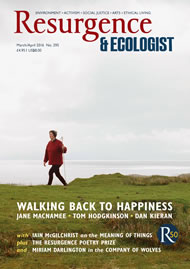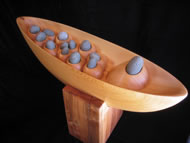One. Am. Life. Word. Egg. Sea. Now. Fear. Stone. Child. Thirst. We. Home. Speak. Wall. I. Safe. Stop. Wood. You. Death. Water. Human. Pray.
Boat People is a prayer for safe passage for people – refugees – travelling by sea. It is a prayer, too, for safe passage through media storms and gale-force politics that would equate refugees with criminals. The work has the serenity and calm of a quieted sea, and holds an implicit rebuke to media bigotry, a reproach to prejudiced politicians.
One captain and 12 passengers, Boat People evokes Jesus and the disciples crossing the Sea of Galilee. A storm whipped around the boat while Jesus slept. His disciples woke him in fear, and he calmed the storm, rebuked the wind and stilled the waves.
The sculpture also evokes a bird’s nest, each lifetime as fertile and fragile as an egg, full of potential and possibility and yet vulnerable to brutality or accident. From egg to hatchling to nestling to fledgling and away, the more you watch the flight of birds, in migration above all, the more beautiful and admirable it seems and the more national borders begin to look artificial, recent, brittle, contemptible and, in their powerful pomp, ugly.
To feed corporate profits, money and capital cross borders without difficulty, even as people, injured by capital’s whimsy, are refused freedom of movement. The migrations of pauperised people are termed ‘criminal’, and migration magnifies the effect of their poverty. The migrations of the wealthy – flitting between houses on different continents – are considered status symbols.
Boat People speaks a sculptural language as uncomplicated as stone, innocent as water, smooth as polished wood. The political language of migration, meanwhile, is twisted, duplicitous, grating and corrupted, so the intrinsically entitled term ‘refugee’ warps into the disenfranchised ‘asylum seeker’, mutates into ‘economic migrant’ and morphs into ‘bogus asylum seeker’, ‘illegal alien’ and ‘criminal’.
Boat people. Nameless; I will give them names. Dante. Einstein. Soyinka. Hugo. Neruda. Ovid. Darwish. Wilde. Yang Lian. Zola. Solzhenitsyn. Chopin. Dietrich. All 13 of them, in one form or another, exiles, refugees and migrants. Dante was exiled from Florence for his politics, and wrote The Divine Comedy – full of themes of exile – as a migrant. Albert Einstein, a German Jew, was accused of treason by the Nazis, who burned his books. He fled as a refugee to the United States. Wole Soyinka, the Nigerian Nobel Prize-winning poet, criticised military dictators and spent two years in solitary confinement before spending years in exile in America. Victor Hugo, who was to write, “I love everything that suffers for freedom,” was forced to flee France, first to Belgium, where he was refused asylum, and then to the British Channel Islands. Chilean poet Pablo Neruda faced arrest because he was a communist. He eventually escaped through the mountains to find refuge in Argentina.
Whether it was for his lascivious work The Art of Love or for political reasons, the Emperor Augustus banished the poet Ovid from Rome to a village on the Black Sea. During his eight-year exile, Ovid finished his masterpiece Metamorphoses. Mahmoud Darwish, the Palestinian poet, lived the life of the internal exile in a nation unhomed. He wrote:
Where should we go after the last frontiers,
Where should the birds fly after the last sky?
Oscar Wilde served a prison sentence for the ‘crime’ of loving men. He left England on his release, fleeing to Paris, where he died, broke and broken.
4 June, 1989. Tiananmen Square. The horror of that day forced the Chinese poet Yang Lian to become a political refugee in New Zealand and then London. He remains in exile. Emile Zola, uncovering the antisemitism within the French army with his work J’Accuse, was forced to flee from France. The Russian writer Solzhenitsyn was deported by the KGB when they read part of The Gulag Archipelago, and spent almost 20 years in exile in America. Chopin infused his music with the folk melodies of his land. When Russia invaded Poland, he took refuge in Paris. And finally: Marlene Dietrich, German singer and actress. In Hollywood as the Nazis came to power, she became a prominent political refugee. I think she would take the captain’s seat.
The Exile as victim. The Exile as freedom fighter. The Exile as artist. The Exile as genius. The Exile as hero. The Exile as villain. The Exile as simply, utterly, totally human, filled with a myriad of human emotions. But without peace, serenity, contentment and security: the emotions of home.
By using a stone to represent each person in the boat, the sculpture suggests both a common humanity – each stone alike is a life – and also a precise individuality – this pebble person rubbed by specific sand and certain time, contoured by a particular life’s impact. Each, by taking a place in the boat, takes it as their right to be the captain of their own soul. Each owns their right to that wooded seat, that nest carved, sanded and oiled until the grain of the wood shows its own signature like a fingerprint.
The wood itself seems to squeeze up to make room, as the pebbles press together, rubbing up in the soft body of the wood. Each pebble is given its own place in a wood nest as each refugee needs their own home, as entitled as a hip bone to its socket, as an egg to a nest. Home not as a gift to be granted or withheld, but as a birthright absolute.
There is, in this sculpture, the sensibility of simplicity from the smooth unadorned materials to the commonality of sea, boat, wood, weight, life, and the simplicity of the human, as naked and as equal as stones on a beach.
Using a pebble per person evokes the democratic process of supposed equals voting, as in ancient Greece, with coloured pebbles to represent different opinions or voices. Each stone in this sculpture is a counter for a human voice, and something as humble as a stone finds the common denominator for all humanity. In essence: equal. In substance: known. In imagination: comprehensible. No illegals. No aliens.
Read Peter Adam’s comments on his work and see more pictures of his sculptures.








